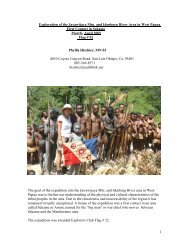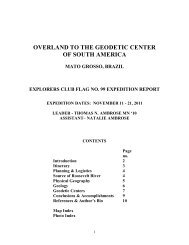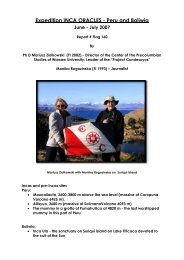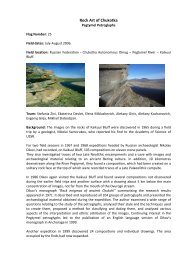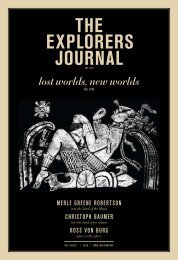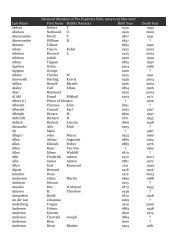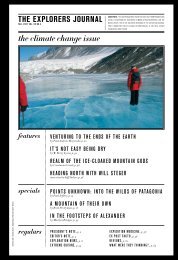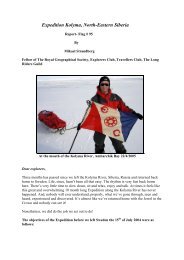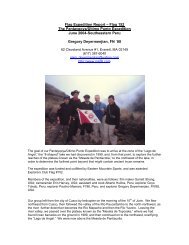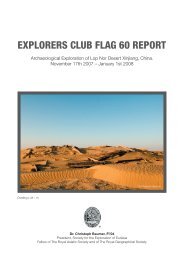square-kilometer halo of sea ice forms around<strong>the</strong> continent, and each spring, trillions of tonsof fresh water are released into <strong>the</strong> ocean as itthaws. This is <strong>the</strong> planet’s great annual climatecycle, <strong>the</strong> <strong>the</strong>rmodynamic engine that drives <strong>the</strong>circulation of ocean currents, redistributing <strong>the</strong>sun’s heat, regulating climate, forcing <strong>the</strong> upwellingof deep-ocean nutrients, setting <strong>the</strong> tempo of<strong>the</strong> planet’s wea<strong>the</strong>r. <strong>The</strong> Antarctic affects all ourlives, but through forces so deep and elementalthat we’re not even aware of <strong>the</strong>m.Our Larsen Ice Shelf Expedition will providean empirical look at how <strong>the</strong> seventh continent ischanging and evolving and dramatically influencing<strong>the</strong> world’s oceans. <strong>The</strong> eastern side of <strong>the</strong>Antarctic Peninsula is seldom seen ei<strong>the</strong>r by scientistsor <strong>explorers</strong>, because it is more exposed tobig seas and rapidly changing wea<strong>the</strong>r, unprotectedby big islands as are <strong>the</strong> better-known parts of<strong>the</strong> western side of <strong>the</strong> peninsula.In March 2002, scientists watched <strong>the</strong> Antarctic’s500-billion-ton Larsen-B ice shelf shatter intothousands of tiny icebergs before <strong>the</strong>ir eyes. Itsbreak-up was an early warning sign. <strong>The</strong> peninsularice shelves are considered among <strong>the</strong> firstindicators of <strong>global</strong> warming. What happened sodramatically to <strong>the</strong> Larsen Ice Shelf suggests <strong>the</strong>rest of <strong>the</strong> peninsula’s ice may one day calve ordeteriorate. No one knows how quickly that willhappen. All this warming and shifting is also havingclear and extremely troubling impact on lifearound its shores. We intend to get as close aswe can to what remains of <strong>the</strong> Larsen Ice Shelf, todocument from sea level how it is today.<strong>The</strong> thread running through all of my expeditionshas been <strong>the</strong> kayaks, which serve as floating ambassadors.It wouldn’t be <strong>the</strong> same to approach<strong>the</strong>se places by Zodiac or fishing boat, or by road.In <strong>the</strong> kayaks we have been able to reach seldomseencorners of <strong>the</strong> world, examine <strong>the</strong> health of<strong>the</strong> oceans from sea level and come face-to-bowwith people whose lives are inextricably tied tothose oceans.Each expedition has been a unique <strong>adventure</strong>.<strong>The</strong> logistical challenges have been enormous,leading to <strong>the</strong> occasional snafu—such as having<strong>the</strong> boats mistakenly delivered to Ho Chi MinhCity ra<strong>the</strong>r than to Hanoi. We’ve struggled tonavigate through ice, through fog, through stormyseas, and through politics. No one, for example,had previously sought permission to take kayaksalong <strong>the</strong> coast of nor<strong>the</strong>rn Vietnam. When I approached<strong>the</strong> Foreign Press Center in Hanoi forpermission in 2000, I was greeted by a directorwith a smile and a cloud of cigarette smoke.“That… will…be…quite…impossible,” he said.<strong>The</strong> year that followed was full of tense, on-again,off-again negotiations with <strong>the</strong> government, whichultimately led to an arrangement whereby I wouldpay a healthy fee for a “filming permit” to be allowedto bring <strong>the</strong> kayaks and <strong>the</strong> team into <strong>the</strong>country. We also had to agree to take along anofficial monitor—a non-swimming, ocean-hating,Elvis-loving, pro-Communist monitor named LinhCua, who kept to his post for every paddle strokedown 1,800 kilometers of coastline, from <strong>the</strong> Chineseborder to Hoi An.While Linh was a slightly disconcerting additionto <strong>the</strong> team, Vietnamese-born social worker andtranslator Ngan Nguyen was a delight. I’d foundNgan, who grew up in New Orleans, through aninternet site read by resettled Vietnamese refugees.Her fa<strong>the</strong>r had been a helicopter pilot with<strong>the</strong> South Vietnamese Air Force, and on <strong>the</strong> lastday of <strong>the</strong> war in 1975 he’d helped shuttle Americansfrom Saigon to a waiting ship. As a reward,he was allowed to bring his family aboard; Nganwas three years old. She grew up to graduatefrom Tulane, <strong>the</strong>n receive a master’s in internationalrelations from Tufts, and she had returnedto Vietnam several times, including a trip in 2000as part of <strong>the</strong> delegation that accompanied PresidentClinton.Though Ngan admitted she wasn’t an experiencedkayaker, we welcomed her to our teambecause of her knowledge of <strong>the</strong> country. Andbecause she was a sou<strong>the</strong>rner traveling for <strong>the</strong>first time in <strong>the</strong> north, each day was a revelationfor her, and thus for <strong>the</strong> team, especially when wepaddled <strong>the</strong> Ben Hai River, which was <strong>the</strong> dividingline between north and south. As we slipped <strong>the</strong>kayaks into <strong>the</strong> river that day, I noticed Ngan wascrying. Rubbing <strong>the</strong> back of her hands across hercheeks, she explained <strong>the</strong>re were two reasons forher tears: first, she had always imagined arriving in<strong>the</strong> north from <strong>the</strong> south, as a victor, and second,because this man-made line, drawn in a Genevaconference room in 1954, had in part resulted in<strong>the</strong> deaths of more than three million Vietnamese,from both sides of <strong>the</strong> tragic conflict.By contrast, on our Oceania trip, we found <strong>the</strong>Tuamotus to be sparsely populated and remote.18
In <strong>the</strong> South Pacific we saw sharks every day, including this pack off <strong>the</strong> coral reef of Rangiroa. Photo by Peter McBrideTwelve thousand people live among <strong>the</strong> 78 coralatolls spread over 2,600 kilometers. Known as <strong>the</strong>“Dangerous Archipelago” by seafarers going backas far as Magellan, who first sighted <strong>the</strong> chain in1521, <strong>the</strong> low-lying reefs have sunk countlessships. Our biggest worry during our two-mon<strong>the</strong>xploration of paradise was <strong>the</strong> daily presence ofour companions through <strong>the</strong> coral: sharks.Whe<strong>the</strong>r we were diving to 50 meters or justkicking through crystal shallows among <strong>the</strong> reefs,<strong>the</strong> sharks were with us. Most were of <strong>the</strong> nonaggressivereef variety, but we were occasionallyvisited by big lemonsand grays. One day,off an atoll called Rangiroa,we swam amid300 of <strong>the</strong> three-meterlongcritters as <strong>the</strong>ybumped our kayaks andour legs and nibbled atpaddles.Phase four, <strong>the</strong>South American trip,took place in <strong>the</strong> fallof 2003, when I took ateam of six—two Americans,one Kiwi, oneBriton, two Chileans—on a nearly 4,000-kilometerloop throughSouth America’s Altiplano(nor<strong>the</strong>rn Chile,nor<strong>the</strong>rn Argentina,sou<strong>the</strong>rn Bolivia), aplace where <strong>the</strong> seaused to be. We began<strong>the</strong> expedition at sealevel, paddling in roughwater along <strong>the</strong> 60-meter-high limestone cliffs off<strong>the</strong> coast of Chile and ended it atop <strong>the</strong> 5,915-meterLicancabur Volcano on <strong>the</strong> Bolivian border.After leaving <strong>the</strong> water to make <strong>the</strong> climb to <strong>the</strong>peak—pulling our kayaks behind us on a portagecart—we found evidence of prehistoric ocean everywhere,from remnants of coral and shells mixedin with <strong>the</strong> high, dry sand to <strong>the</strong> biggest salt lakein <strong>the</strong> world, Salar de Uyuni, which is spread overmore than 12,500 square kilometers in Bolivia.Searching for water in <strong>the</strong> driest place on Earth,dragging kayaks into <strong>the</strong> 4,300-meter-high desertmay seem quixotic, but we were drawn by <strong>the</strong>intense beauty of <strong>the</strong> high, mineral-rich lakes, aswell as by <strong>the</strong> thought that every step we took hadonce been covered by ocean.Each expedition has brought its own hardships.In <strong>the</strong> cold seas of <strong>the</strong> Aleutians, we figured that ifwe capsized we had 15 minutes to live. <strong>The</strong> SouthPacific, as blue and perfect as it was, delivereda nasty staph infection that spread to four of ourfive team members. <strong>The</strong> Altiplano was high anddry, sucking air from our lungs as we paddled andclimbed. In Croatia, camps on <strong>the</strong> 1,200 islandswere few and far between, which meant sleepingon tiny spits of rockand sand, or on cementboat docks. Butby far <strong>the</strong> most physicallyexhausting wasour fifth trip, in 2004,when photographerPeter McBride, environmentalistJ. MichaelFay, and two Africans,Sophiano Etouck andAime Jessy, joined mein Gabon.In this small WestAfrican nation, wecircumnavigated <strong>the</strong>country’s first nationalpark, Loango. <strong>The</strong> combinationof unrelenting38ºC heat; little food;long, long days on <strong>the</strong>ocean; and a three-dayjungle portage took aheavy toll. For me, <strong>the</strong>physical challenge washeightened by <strong>the</strong> factthat I was traveling with Fay, who had gained acclaima few years back for spending 453 daysstraight walking across <strong>the</strong> Congo.Yet, as always, <strong>the</strong>re were astonishing rewards.After paddling into high winds across wide lakes,<strong>the</strong>n up a 70-kilometer river—spending one nightsleeping in our kayaks in a flooded forest—wespent several days on <strong>the</strong> ocean. <strong>The</strong> typical dayended with a beautiful equatorial sunset formingbehind us, and we sat in <strong>the</strong> surf zone, not quiteready to paddle in to <strong>the</strong> beach, despite havingbeen in <strong>the</strong> kayaks for eight hours. As we backpaddled,being gently pushed toward <strong>the</strong> sandy<strong>the</strong> <strong>explorers</strong> <strong>journal</strong>



